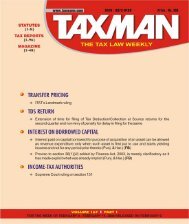news round up - Taxmann
news round up - Taxmann
news round up - Taxmann
- TAGS
- news
- round
- taxmann
- taxmann.com
Create successful ePaper yourself
Turn your PDF publications into a flip-book with our unique Google optimized e-Paper software.
2010] Comments of DoR on First Discussion Paper on GST 129<br />
COMMENTS OF THE<br />
DEPARTMENT OF REVENUE (DoR)<br />
ON<br />
THE FIRST DISCUSSION PAPER ON GST<br />
Sr. Para No. Issues Comments of the<br />
No. of the DoR<br />
Discussion<br />
Paper<br />
1 2 3 4<br />
1. 3.1 It is important to take note of the significant<br />
administrative issues involved in designing an<br />
effective GST model in a federal system with<br />
the objective of having an overall harmonious<br />
structure of rates. Together with this, there is<br />
a need for <strong>up</strong>holding the powers of Central<br />
and State Governments in their taxation matters.<br />
Further, there is also the need to propose<br />
a model that would be easily implementable,<br />
while being generally acceptable to stakeholders.<br />
Agreed.<br />
2. 3.2 Keeping in view the report of the Joint Working<br />
Gro<strong>up</strong> on Goods and Services Tax, the<br />
views received from the States and Government<br />
of India, a dual GST with defined functions<br />
and responsibilities of the Centre and<br />
the States is recommended. An appropriate<br />
mechanism that will be binding on both the<br />
Centre and the States should be worked out<br />
whereby the harmonious rate structure along<br />
with the need for further modification could<br />
be <strong>up</strong>held, if necessary with a collectively<br />
agreed Constitutional Amendment.<br />
3. 3.2(i) The GST shall have two components: one<br />
levied by the Centre (hereinafter referred to<br />
as Central GST), and the other levied by the<br />
States [hereinafter referred to as State GST].<br />
Rates for Central GST and State GST should<br />
be prescribed appropriately, reflecting revenue<br />
considerations and acceptability. This<br />
dual GST model would be implemented<br />
through multiple statutes (one for CGST and<br />
a SGST statute for every State). However, the<br />
basic features of law such as chargeability,<br />
definition of taxable event and taxable person,<br />
measure of levy including valuation provisions,<br />
basis of classification etc. should be<br />
uniform across these statutes as far as practicable.<br />
Dual GST model with<br />
appropriate binding<br />
mechanism to<br />
harmonise the various<br />
important aspects<br />
of the GST like<br />
rate structure, taxation<br />
base, exemption<br />
etc. between Centre<br />
and States is agreed.<br />
Agreed. In addition,<br />
IGST on inter-State<br />
transactions should<br />
be levied by the Centre.<br />
SGST on imports<br />
should also be levied<br />
and collected by the<br />
Centre. Centre should<br />
pass on SGST collection<br />
on imports to<br />
concerned States on<br />
the destination principle.<br />
GOODS & SERVICES TAX CASES ❑ JANUARY 20 - FEBRUARY 4, 2010 ◆ 11











![“FORM NO. 3CEB [See rule 10E] Report from an ... - Taxmann](https://img.yumpu.com/45480232/1/190x245/form-no-3ceb-see-rule-10e-report-from-an-taxmann.jpg?quality=85)





